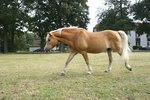If you've been to a harness racing track, you know that Standardbred pacers and trotters compete in separate races, not against each other. That's because they race in two distinct gaits. Both are two-beat gaits. Pacers tend to race faster than their trotting relatives. Once you know what to look for, you'll discover the difference between trotting and pacing is easy to discern.
Harness Racing
Harness racing got its start when horses and buggies were the primary mode of transportation -- as is often the case with boys and wheels, buggy drivers challenged each other to informal races. By the late 18th century, tracks and some regulations were in place. Trotters and pacers don't race against one another. But the two horses use similar equipment. A driver sits behind the horse in a sulky, holding the driving lines to control the horse. The horse is "in harness," which means wearing the bridle, girth, saddle and crupper. The horse also wears a headpole that runs along his head and neck to prevent head-turning.
Standardbreds
Descended from the English thoroughbred Messenger -- along with breeds such as the now-extinct Narragansett Pacer, the Morgan, Hackney and others -- the Standardbred originated in America. More than 90 percent of modern Standardbreds trace their lineage back to Messenger's great-grandson Hambletonian, one of the fastest trotters of the mid-19th century and a prolific sire. The majority of Standardbreds are bay or brown; greys, chestnuts and blacks occasionally occur. Standardbreds range in height from 14 to 17 hands. The breed gets its name from a "standard" time for racing one mile. The current standard for 2-year-olds is 2 minutes 20 seconds; the standard for 3-year-olds is 2 minutes 15 seconds.
Trotters
If you've ridden horses, you're familiar with the trot, or the jog as it's called in Western riding. When a horse trots, he moves diagonally paired legs simultaneously. That means he's moving his back left leg at the same time he's moving his right front leg, and his front left leg in unison with the rear right leg. A trotting racehorse performs this gait at high speed. Some trotters wear trotting hopples, simple front leg loops, to aid in keeping the gait.
Pacers
Far more common on the racetrack than trotters, pacers move the legs on the same side of their bodies together: It's a lateral gait rather than a diagonal one. Most pacers wear hopples on all four legs to help with gait maintenance. Occasionally, you might see a free-legged pacer, a horse racing without hopples. Many pacers trot naturally while turned out in a field; they can be trained to trot for second careers as riding horses. The opposite isn't true -- trotters don't usually pace. "The New York Times" reported that researchers in Sweden discovered a gene called DMRT3 that determines whether or not a horse can pace. With genetic testing, breeders can now make decisions knowing that particular horses have DMRT3 and are unlikely to produce offspring that break their gait while racing.
References
- Standardbred Pleasure Horse Organization of Maine: Frequently Asked Questions
- Kentucky Equine Review: The American Standardbred: Trotters and Pacers Rule the Harness Tracks
- Standardbred Pleasure Organization of New Jersey: A History of the Standardbred Horse
- Scarborough Downs: Harness Racing History
- New York Times: Horses’ Ability to Pace Is Written in DNA
Writer Bio
Jane Meggitt has been a writer for more than 20 years. In addition to reporting for a major newspaper chain, she has been published in "Horse News," "Suburban Classic," "Hoof Beats," "Equine Journal" and other publications. She has a Bachelor of Arts in English from New York University and an Associate of Arts from the American Academy of Dramatics Arts, New York City.



